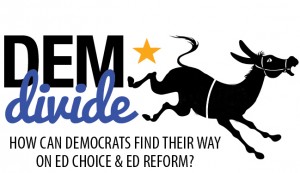Editor’s note: This is the fifth post in our series on the Democratic Party’s growing divide over ed reform and ed choice.

by Richard Whitmire
This spring I attended the Democrats for Education Reform conference in Lake Placid and watched a line of teacher union protesters, including Randy Weingarten, stand in the cold Adirondack rain and wave signs at us with slogans such as “Public Education is not for Sale.” I recall thinking: “This is going nowhere good.”It’s hard to be optimistic about the possibility that this political divide among Democrats will narrow. In Chicago, fiery teachers union president Karen Lewis is close to running against Democratic Mayor Rahm Immanuel. In New York, progressives still haven’t forgiven Democratic Gov. Mario Cuomo for putting down Democratic Mayor de Blasio over charter schools. In Los Angeles, where all the players are Democrats, the school board temporarily severed two of the highest performing charter schools there. And then there’s the NEA weirdly calling for the resignation of Education Secretary Arne Duncan. Yes, that nice Democrat Arne!
All these conflicts have one thing in common: Democrats v. Democrats. Or, to put it more precisely, liberals (think Cuomo) v. progressives (think de Blasio). While there are many education issues that fall along this divide, only one appears to have no resolution: charter schools. The bluer the state, the bigger the divide. On July 16 the Massachusetts Senate rejected an attempt to lift the very tight lid on charter schools, despite the fact that the state has the nation’s highest-performing charters.
What’s the problem? The fact that top charters have gotten significantly better in recent years (I define that as roughly the top fifth, the charters capable of adding a year-and-a-half of growth for every school year) presents a broad and enduring threat to traditional school districts and unions: These charters can both replicate quickly and produce student results that most districts can’t match. How to contain such an existential threat? Superintendents and unions, joined in common cause, rely on friendly legislatures (think of what just played out in Massachusetts) and lawsuits (think of San Jose, where opponents use zoning laws to slow down charter expansion).
Will the “pushback” strategy work? Definitely, at least in the short term. But not the long term. Given that parental choice is relatively widespread, and parents are not inclined to relinquish that choice, all that will matter in the end are quality schools, whether they are district or charter. But that “end,” can be far, far away. The power of the anti-charter forces to block expansion is considerable, and, at least from my perspective, that means denying quality schools to thousands of parents. How to solve that dilemma?
There is no complete solution to this standoff. I’m thinking of those Shelby County teachers frozen out by Tennessee school reforms. Those teachers, who lack school placements, are forced to sit on the sidelines as they watch young TFA’ers and others take their jobs. Sure, there’s a solid case for allowing principals to make their own hiring choices, but will those laid-off teachers ever forgive the “reformers” who brought this on? Will they ever have a kind word to say about TFA? Not likely.
That said, there are pathways forward that sidestep the hottest of the hot spots and raise the possibility of exposing more students to educations that are more likely to prepare them for the future. I lump them in two categories, by city: Houston and Washington D.C.
Houston. In Houston’s Spring Branch schools I found my favorite model, one that could easily spread to scores of similar districts. There, a superintendent curious about the nearby high-performing charters, KIPP and YES Prep, visited both and came away with a simple conclusion: I like their school culture, I like their sense of urgency, and I want to infuse that into our district. He took two middle schools and co-located KIPP in one, YES in the other. Each of the charters will continue to add a grade a year, with YES creating a high school program.
What’s different here is that these are not New York City-style co-locations. Here, the schools are learning partners. The district is starting to combine professional development and draw on broader successful charter initiatives, especially the college counseling programs where it is expected that each student will go to college, with exacting plans to make that happen. The superintendent also hired a top KIPP executive to be in charge of broader transformational change in the district.
Each side has an incentive to make the relationship work. Spring Branch schools welcome the higher test scores turned in by the KIPP and YES students. Those scores count toward the average of the entire school. From the perspective of the charters, they get access to high-quality space without having to pay for new construction. The best part of the Spring Branch model: It has played out without controversy.
Washington, D.C. This city is a surprise player in the education wars. Once former chancellor Michelle Rhee was forced out, it was assumed by many that the bad old days of D.C. education would return. Washington, along with Newark, Detroit and New Orleans, has long jockeyed to avoid the worst-in-the-nation label. But that didn’t happen. With hindsight we can see that the Rhee reforms, buttressed by her successor Kaya Henderson, have stabilized district schools, allowing them to compete with the district charters, which were also undergoing rapid improvement. What that means today: The District schools and charter schools educate nearly equal numbers of students amidst what can be described as creative competition. It isn’t always friendly, but it’s not war, either, and the result is a reinvigorated education system ranked by the federal government as the fastest-improving urban district in the country.
Either pathway, cooperation in Spring Branch or real competition in the District, seems to lead to better student outcomes—while sidestepping the worst of the Democrat v. Democrat fighting we see elsewhere in the country. Both pathways are win-wins for students.
Richard Whitmire is a veteran journalist and author, most recently, of “On The Rocketship: How Top Charter Schools are Pushing the Envelope”
Read the rest of the Dem Divide series below
Gloria Romero: Money leads Democrats to put teachers unions over poor kids
Ben Austin: Democratic leaders will follow parents on ed reform, eventually
Joe Williams: Suburbs hold key to resolving Dem tensions over school choice
Myles Mendoza: Rahm Emanuel offers lesson for Democrats on ed reform
Rep. Marcus Brandon: African-Americans must blaze own path on school choice, ed reform
Doug Tuthill: New type of teacher union is key to relieving Democratic tensions



Mr. Whitmire starts off with a thesis – there is a divide on the issue of public education among Democrats. (But I also note that this is true for conservatives as well although for very different reasons.)
But then he does what any good ed reformer does – gives examples of “great” charters and wonder why everyone does just get on-board. It’s that know-it-all attitude that is off-putting at the least and insulting at the worst. All is NOT well in the charter world. If charters continue on, we need a lot more accountability and a lot fewer feel-good charter stories.
I think that Spring Branch is a good example of what truly should be happening between charters and districts but it is certainly an isolated event. And, I wager that down the line, all will not be the kumbaya that seems to be happening now (see NYC co-locating).
Those of us who are progressives are just not going to roll over because DFER or anyone else tells us we should. Arne Duncan has done many thing in a unilateral manner. Dem or not, I don’t like his actions and I do not trust him. Sorry.
I think many of us are willing to talk but not be shushed or talked down to. And with the coming presidential election, I hope no one thinks they can just take for granted party support.
I’m not certain where your get your information about charter “success” stories but I’d venture a guess it’s from charter marketing brochures. If the Dems want to have a conversation with us, publish the names of any member of DFER who sends their own child to KIPP or Rocketship or another charter chain and then maybe we can have a coffee and chat. Until then, we’re not going to talk to the wall.
It couldn’t be any clearer that the Dems are as enamored with education privatization schemes as are the Republicans. At least, the Republicans are open about their education plans. Arne et al., hide behind weasel words and civil rights rhetoric after overseeing massive public school shutdowns and deliberate resource starvation in poor neighborhoods in every city in the country.
With DFER & Robert Gibbs are sending out their attack dog Campbell Brown, any reaching out by Dems to communicate is entirely symbolic and exploitative. I hope someone in the DC village realizes they can’t step on the necks of their middle class base and expect blind loyalty. After all, many of us remember this:
https://www.epi.org/publication/grading_the_education_reformers/
“The reformers’ arrogance is best on display when Brill gloats about the charade of appointing anti-reformer Linda Darling-Hammond to lead Obama’s official post-election education planning, while DFER, with funds from Eli Broad, wrote a secret memo for the “informal yet real education transition team.” Jon Schnur organized the effort and strove to calm his nervous fellow-reformers, assuring them that the Darling-Hammond appointment was only a sop to a faction that would have no real influence, while DFER’s secret memo set forth the Administration’s actual policy – including the naming of key Gates Foundation and Teach for America operatives for crucial administration policy posts, and calling for use of student test scores to evaluate teachers.”
Hello Joan, Republicans use the civil rights rhetoric too. Giving all families options and publicly supporting those choices is the RIGHT thing to do. I think you may have a cartoon interpretation of what school choice supporters believe.
According the article above, “the Federal government ranks DC as the ‘fastest improving urban district in the country.'” Based on what metrics? Where are these rankings? Somehow they seem to stand in stark contrast to the following (current) analyses indicating that “D.C. came in last place, ranking as the least safe place to go to school, along with low test scores and high dropout rates.” https://www.businessinsider.com/states-with-best-and-worst-school-systems-2014-8
The following collection includes a post by the American Bar Association raising concern about students’ rights not being met in charter schools. Worth considering, along with the many other articles that provide greater context about charter school expansion: https://www.scoop.it/t/charter-choice-closer-look
Hi ConnectEdProf, thanks for reading us and taking time out to comment. I’m not totally sure which academic indicators Richard Whitmire had in mind, but DC has gotten a lot of positive ink recently for rising NAEP scores. Here’s but one recent article:
https://blogs.edweek.org/edweek/curriculum/2013/12/urban_naep_results_dc_schools_.html
Look at the website I bring about https://www.cornbreadhemp.com/products/cbd-balm !